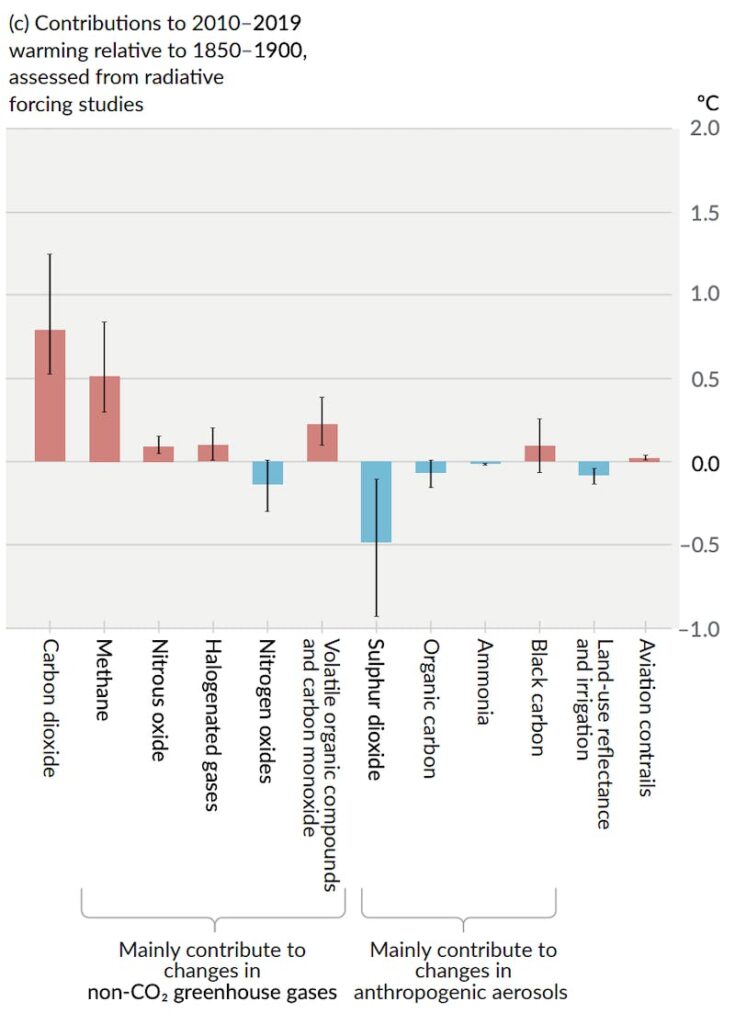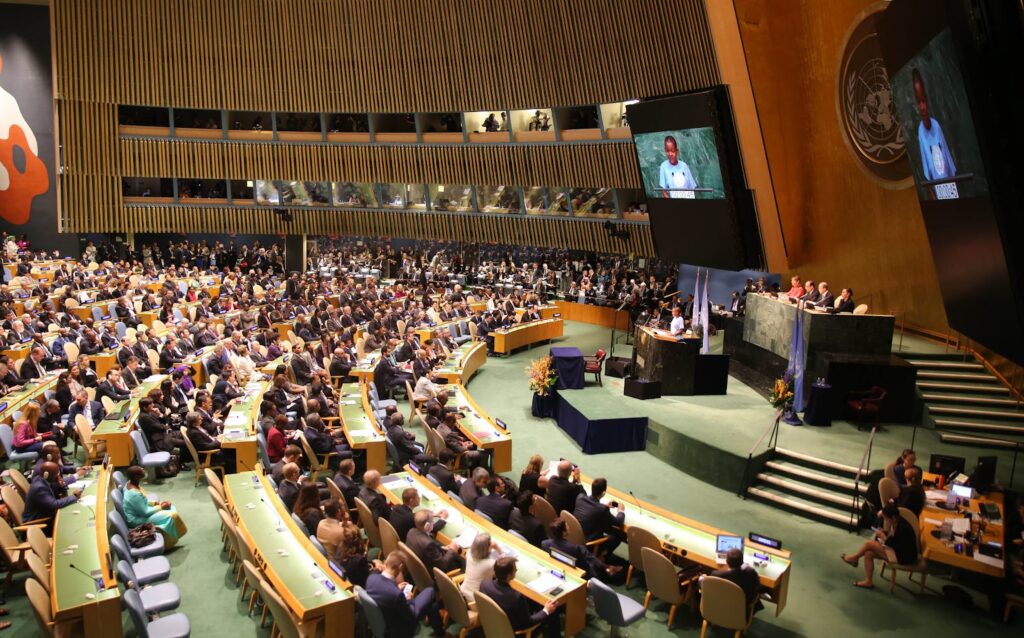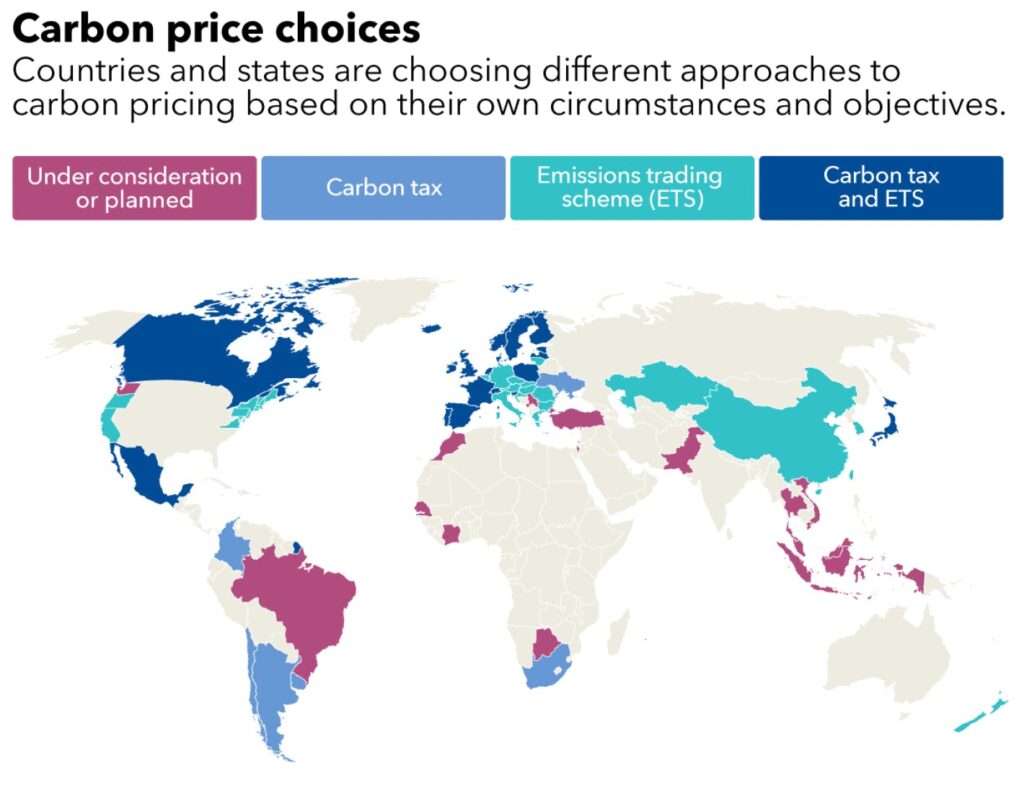Today we’re looking at carbon credits.
As bad as climate change has the potential to be, the real tragedy is our seeming inability to talk about it without eliciting grimaces and eye rolls from half the room.
Climate change is, to the chagrin of many, an evergreen topic (har har!) It’s a generation-spanning mega-event that we all sort of wish would stop on its own. But that won’t happen, so education is the only way forward.
We recently spoke with Nori CEO Paul Gambill on our podcast. Paul and Horacio talked about buying & selling carbon removal credits through their platform. As I listened to the podcast, I realized I didn’t know much about how this all works.
So what exactly are carbon credits? How are they traded? Do they actually help the environment? And who can invest in them?
Let’s go 👇
Table of Contents
We fixed the ozone. Can we fix the climate?
Climate change might turn out to be the single most pressing global issue human civilization has ever faced.
As usual, both the wild optimists and the wild pessimists have been wrong. Naive optimists thought we had more time to act than we did, while pessimist alarmists predicted human extinction by the year 2100. Right.

But what fascinates me about climate change is how little optimism there seems to be around it. It’s easy to be negative, but a) it’s unproductive, b) it’s demotivating (if the world is gonna burn, why bother trying to fix it?), and c) it ignores the fact that some truly innovative mitigation weapons are being built as we speak.
I believe humans will ultimately be able to exert a small amount of control over the climate. After all, we have big precedence here: People often forget, but we saved the ozone layer!
This is well understood by Australia and New Zealand. The ozone hole formed over the south pole, so Aus & NZ were (and still are) affected by it more than any other countries. (Even today, Australia still has the highest rate of skin cancer in the world, and New Zealand is second.)
Our ability to swiftly phase out CFCs at the Montreal Protocol has to be one of the most under-discussed events of the past 50 years.
One thing’s for sure: In 2022, people are less likely to call climate change a hoax than ever before. And honestly, thank God, because denial got us absolutely nowhere.
Now we can get down to business.

The Paris Agreement
We know CO2 is responsible for most warming, so surely we can band together again and agree to reduce CO2, right?
Well, not quite. It’s one thing to ask countries to use a different type of deodorant. It’s another to ask them to change the fundamental nature of their core industries — especially those countries that are just starting to industrialize.
But there has been some progress. The 2015 Paris Agreement got countries to agree to target carbon neutrality by 2050.
Its goal is to limit global warming to below 2 degrees Celsius above pre-industrial levels. We’re facing irreversible climate changes either way, but if we can keep it below 2 degrees, we might just hold off a long-term apocalypse. That’s the thinking, at least.
Both America and Brazil have backed out, and the agreement sets no binding obligations to collectively meet the goal anyways. But the Paris Agreement has sparked low-carbon solutions and introduced even more new markets for carbon credits.

What are carbon credits?
Carbon credits are basically a permission slip to pollute.
Each year, companies that emit the most pollution (think mining, oil, agriculture) are assigned a capped number of carbon credits, representing their annual emissions allowance. Each credit equals one metric ton of CO2.
If a company’s emissions stay below its cap, the credit surplus can be either retained for future use, or sold into the carbon market. Going above the cap means you need to purchase carbon credits — usually from an “under-emitting” company.

A single carbon credit equals one ton of CO2 emissions. So, if a company has 100,000 credits, it can emit one hundred thousand tons of carbon each year.
Different countries have different limits, and plenty of companies go over their number. When they do, they can buy additional carbon credits to get back under the limit.
Continuously exceeding a cap without purchasing additional credits is often illegal and can lead to court cases & massive fines.
The history of carbon credits
The carbon credits story starts in Kyoto, Japan in 1997.
The Kyoto Protocol was a meeting organized by the United Nations to address global warming. The objective was to stabilize greenhouse gases to stop the effects of climate change.
It was a landmark effort, because it committed countries to binding standards of action and introduced a global carbon market. Developed nations agreed to attempt an emissions reduction of 5.2% by 2012.

But unfortunately, this first attempt at a global carbon trading scheme failed.
The United States and Australia were the only developed nations to reject the agreement, arguing it was too restrictive and would smash their economies. Furthermore, over 100 developing nations were exempt — including, incredibly, China and India.
America and China’s continued production of limitless carbon emissions basically offset member nations’ positive progress.
Carbon credits quickly became a source of corruption among developing countries. A 2015 study found that 80% of projects that used Kyoto’s carbon credits weren’t actually helping the environment at all.
Not great results. But Kyoto laid the groundwork for the carbon markets we have today.
Credits vs offsets
People often conflate carbon credits with carbon offsets.
Both were born around the same time, but they’re very different.
Carbon credits (compliance)
Carbon credit markets are compliance markets, driven by domestic regulation. Governments set emission targets which are designed to slowly decrease over time.
Carbon credits used in these cap and trade compliance programs are managed by governments, such as the California Cap-and-Trade Program, overseen by the California Air Resources Board.

Carbon offsets (voluntary)
While carbon credit markets are compliance markets, carbon offsets are voluntary markets driven by voluntary emissions reduction targets, corporate responsibility, PR, and the goodness of the CEO’s heart (aww!)
Offsets work by offsetting carbon’s impact on the environment, for example:
- Investing in renewable energy
- Reforestation (planting trees, growing kelp, restoring mangroves)
- Regenerative farming (like what our friends at farm.vc are facilitating)
- Building better public transport infrastructure
- Methane capture
- Subsidizing electric vehicles
Once the offset is created, it can be sold to companies. We’ll get into how this works later on.

How big are carbon credit markets?
Launched in 2005, the European Emissions Trading System (EU ETS) was the world’s first large greenhouse gas emissions trading system.
Each year about $272 billion worth of carbon credits are traded. These credits represent the equivalent of 10.5 gigatons of CO2, or about half as much CO2 as the US emitted last year.)
The EU was first, but it’s not the biggest. China’s new emissions trading system launched in 2021, and is already the world’s largest carbon market: 3x bigger than the EU’s.

The global voluntary carbon offset market is much smaller. In 2021 it hit $1 billion for the first time ever, but as pressure on companies intensifies, experts suggest this market could grow to $25 billion by 2030.
Do carbon credits actually help reduce emissions?
There have been some very legitimate criticisms and failures in the system.
By putting a price on carbon, the thinking goes, businesses will be nudged towards creative solutions to pollution. But these new markets can be gamed by large companies and corrupt governments.
- While it has incentivized offsets, it has also incentivized corruption and fraud. Double-spending on the (now-worthless) Kyoto carbon credits is one example.
- Because these markets aren’t globally regulated, pricing for credits is arbitrary and opaque. Carbon brokers are notorious for gouging.
But the biggest criticism is from environmentalists who say carbon credits don’t actually require businesses to change their behavior, just pay for it. Like a Catholic going to confession, the world’s biggest polluters basically greenwash themselves by buying credits & offsets.
Rather than fixing a problem, carbon credits may just be a band-aid solution delaying the inevitable; one that doesn’t push society forward at the speed it needs to move.
But you gotta start somewhere.

How much do carbon credits cost?
Since there is no global governing body, carbon credit pricing is all over the place, and can have severe volatility. (Like, crypto-level volatility)
Every region is different. For example, in Australia prices skyrocketed at the end of 2021, hitting USD $36.65. But today, the price is about half that: $18.76

- California’s credits cost $28.27
- New Zealand charges $46.04
- The European Union is also on the more expensive side, at $46.48
According to the Paris Agreement, the price of carbon credits must be kept in the $40-80 dollar range to prevent temperatures from rising by less than 2 degrees.
At the moment, the average global price of carbon is $6 per ton, which is too cheap to meet this goal.

Who sells carbon credits?
On the compliance side, institutions that regulate carbon credits have public registries where you can find official distributors of carbon credits.
As the voluntary offset market has grown, so too has the number of private companies that offer offsets to institutions and individuals. But before they can be sold, offsets need to be audited.
The auditing process works like this:
- A company (or say, a farmer) generates a carbon offset through an agreed-upon initiative
- A carbon auditor is an independent verification body that reviews and verifies the claim
- The auditor certifies X number of offsets to the company
- The credits are added to the registry and can then be sold to any buyer, including speculators and brokers
Often, developers don’t have the understanding or means to sell carbon credits themselves. Instead, they turn to carbon brokers like Bluesource who buy credits wholesale and sell them at a markup — often to other brokers.
How to invest in carbon credits
When you buy a long-haul airline ticket, you often get the option of offsetting your emission by paying an extra few bucks. If you do this, you’re actually buying voluntary carbon offsets, just like those created by renewable energy companies.
Investing in carbon in this way doesn’t really have any individual economic benefit. It’s ultimately just a way to reduce your footprint and do your bit for the environment.
But people can invest in carbon and benefit. The easiest way to do so is via carbon exchanges.
Carbon exchanges
Three prominent examples include:
- New York’s CBL market
- The global ClimateTrade Marketplace
- Singapore’s AirCarbon
These carbon marketplaces work similarly to commodities exchanges, with price transparency and trades executed through a centralized order book.
This process is about to get a lot easier. In mid-2023, Carbonplace will be released. This is an enormous joint effort powered by seven international banks. Their goal is to create the standardized exchange for voluntary carbon credits. Sounds pretty cool.

Private companies
Founded in 2017, Nori is a blockchain-based carbon removal marketplace. They work with farmers to create offsets through regenerative agriculture, and facilitate the sale of those offsets to small businesses who are trying to be carbon neutral.
We had the pleasure of speaking with Nori’s founder and CEO, Paul Gambill. Paul’s a wealth of knowledge, and it’s a really interesting chat. Have a listen.
As Paul discusses, to actually solve climate change, we’ll need to remove an astonishing 1.5 trillion tons of CO2 from the atmosphere. It’s going to require a lot more than farming. Yet regenerative farming is the most affordable and scalable method of removing carbon today.
More on this in an upcoming issue.
In the meantime, here are some interesting companies in the carbon credits ecosystem:
- TerraPass helps consumers and businesses offset their carbon footprints by investing in renewable energy projects like solar farms. They also provide the funding for these projects to get up and running.
- Green Mountain Energy sells carbon offsets, and renewable energy to customers in 8 US states.
- Bioassets invests in carbon and biodiversity assets
- Carbon Credit Capital links domestic and international partners to high-quality carbon emission reduction projects
- Aera Group is the largest originator and trader of African carbon credits
- South Pole Group is a climate consultancy that develops and finances carbon offset projects
- Biofílica is a Brazilian company generating credits through afforestation & reforestation
- Carbon-Ion Equity. Carbon-Ion is an EV charging company designed to allow cells to be charged up to 50x faster
- GreenTrees is a global leader in reforestation
- 3Degrees helps organizations achieve renewable energy and decarbonization goals
- Schneider specializes in energy management for homes, buildings, data centers, infrastructure and industry
- Forest Carbon restores degraded wetland forests
Tokenization
You can also invest in carbon credits through carbon credit tokenization.
One example of this is the Climate Coin Initiative. This token is backed by carbon credits from projects in negative-emissions territory. Each Climate Coin represents 1 metric ton of quality carbon offset credits.
The token can be used as collateral on exchanges and popular decentralized finance platforms.
Climate Coin provides borrowers with a guarantee on the underlying assets, which is collateralized by Climate Coin tokens representing the underlying assets.
Public companies
And lastly, Carbon Streaming Corp is a publicly-traded company that invests in international developers generating voluntary carbon offsets.
Their portfolio includes projects like the Bonobo Peace Forest conservation, which protects endangered bonobos and their habitat.

Carbon ETFs
The largest carbon ETF in the world is KraneShares Global Carbon Strategy (KRBN), which is traded on the NYSE.
The fund tracks the Bloomberg International Carbon Futures Excess Return Index, which measures the performance of global carbon futures, with a particular focus on major markets, including:
- The California Carbon Allowance auctions in the US
- The European Union Allowance Auctions in the EU
- The Regulatory Instrument for Market-Based Measures scheme in Australia
- The New Zealand Unit Auction in New Zealand

The future of carbon credits
To get to net zero, our carbon footprint is going to need to shrink.
The more we can do to offset our carbon emissions today, the easier it’ll be to reduce that footprint in the future. So far, carbon credits are a policy-proven way to do exactly this.
The amount of carbon that’s allowed for use globally is dwindling. And any investible market with a finite, dwindling supply is worth considering.
Some say carbon credits are a band-aid solution; that we should focus on cooling the climate directly. (Who knows, someday our problem might be that we even cool the atmosphere too much.)
How successful carbon credits will be in getting humanity to net zero by 2050 remains to be seen. We’re still a few years away from truly measuring the impact on a broad scale. But all signs point to carbon credits staying around for a very long time.
As I said at the beginning, there is reason for positivity and hope. The voluntary market is growing, and I think there will be a lot more money flowing into voluntary carbon financial markets over the next few years.
I’d like to highlight one particular project which has demonstrated a fantastic use case for carbon credits, and deserves a big mention.
On the west coast of Africa lies a country with some of the world’s densest and richest rainforests – Gabon.

An astonishing 88% of Gabon is covered in rainforests, and its trees absorb 125 million tons of CO2 every year.
Due to the government’s conservation efforts, Gabon’s elephant population has actually increased by 35,000 since 1999.
With the help of the United Nations’ REDD+ infrastructure, Gabon plans to sell the carbon offsets generated by the nation’s rainforests. The 1 billion tons of CO2 absorbed from 2010-18 is equivalent to 90 million carbon credits.
The credits are going to hit the market in November. Gabon’s environment minister, Lee White, believes the country can sell these credits at $25 – $35 a pop, which would generate $2.25 billion for the developing nation.
Instead of giving in to pressure from big oil and mining companies to cut down their magnificent forests, Gabon can thrive on income generated from one of the world’s most beautiful habitats.
Ultimately, the project will both mitigate climate change, monetize conservation, and protect some of the world’s natural beauty.
If Gabon’s plan is successful, this may finally be the clear and profitable path to long-term stability that developing countries are looking for. 🍃












